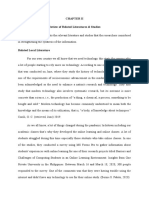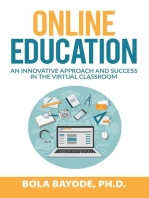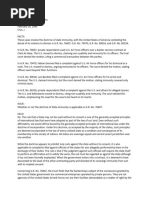Assignment 3
Uploaded by
TyyazAssignment 3
Uploaded by
TyyazChoice of VLE
I am impressed with Edmodo, Haiku and Schoology. My duties at my school would lead me to
choose a more comprehensive VLE that would start encompass the following:
Attendance recorder
Ease of access and manipulation
Comprehensive resource storage
Multiple access technology tools
Inexpensive
Assessment and evaluation
We are currently using EDU2.0 in certain subject areas but due to the costs, bandwidth
challenges we have slowed down in our efforts to fully integrate this VLE into out curriculum.
Finance is an issue to unlock some of the premium features as I have noticed with most of the
other VLEs. However in this case Edmodo is my choice as it the closest to EDU2.0 with what it
offers. Like Edu2.0 it is very comprehensive and allows the facilitators to present content in
various ways to the learner and can integrate most forms of media. It can also monitor student
attendance, access, progress and content at any given time since all information is in a cloud.
Students can manipulate the platform as they would their Facebook accounts. There is no cost
attached to the basic package which makes this VLE accessible by all. This is key component in
our current financially challenged environment.
Finally facilitators, parents and students are able to track progress and conduct both assessments
whereby students can receive results in real time upon completion of their examinations. The
quality of the print in examinations is also improved as this is in the digital format.
Edmodo also has a support system where training is provided in the manipulation of the platform
along with upgrades where necessary as time progresses.
Access to Infrastructure
At my school we do have labs that are networked and have internet access. We also have a
wireless access in certain classrooms. However the bandwidth presents a serious challenge as it
is not sufficient to cater for classes of thirty five and labs at the same time. Therefore we
sometimes had to conduct online examinations in batches or make arrangement to shift to areas
where wireless access is available. Therefore, what may take five minutes to complete may take
thirty minutes due to limited bandwidth as our school s very dependent on technology for most
of its programmes. We are in consultation with the Telcom operators, working on improving the
bandwidth and wireless connectivity for the upcoming academic year.
Our machines have also presented a challenge in that they have been operating for the past
eleven years since manufacturing date and can only handle this much memory intensive
programmes. Therefore we experience high levels of latency in our operations. Knowing this a
lot of planning and adjustments are done beforehand to accommodate facilitators in the
integration of ICT into their programmes. EDU2.0 for example was used as a pilot in certain
subject disciplines and was very successful. We are going through a transition process which will
occur in two phases. By year end barring no force majeure we will be able to handle full access,
internet connectivity and hardware upgrade for the entire school at the same time. This is truly a
dream for any learning institution in St. Lucia.
Review of Article
In some regard this article highlights the key challenges schools are faced with in the integration
of technology to the classroom. I have always believed if students are motivated facilitators have
no choice but to get with the programme. Our students today place demands and expectations
on school that we must coral into realistic goals. It has always been thought that you go to
school, get educated and then a job is waiting or the money is there for you to further your
education. This is not the reality. Our economic climate and governments are asking us to
produce entrepreneurs who are innovative and ready for the world of work and can make solid
contribution to the economic development of our countries at the age of sixteen.
However there are a few factors we need to put in perspective. Back in the day students
graduated from Secondary School at seventeen, eighteen or nineteen and in minority cases on the
verge of 20, with a sense of maturity and ready to face challenges because of the nature of
society back then. Today students are graduating at sixteen. Some of whom are just turning 16 in
their final days of examination. They are very much immature and feel that society owes them
something and that a job or higher education is an entitlement. They have not fully recognized
that this is not so and they have to be intrinsically motivated more than ever now. Our economic
climate too, is of no assistance as it suggests that resilience and who you know is the key to
survival and not education.
As stated in the article the majority of our teachers try to infuse some form of technology into the
classrooms. Though the buy in maybe slow, attempts are being made. As a Secondary school
teacher I have realized that students on the other hand have moved past us in that they expect
everything that they see in the media must be introduced in the classroom almost with immediate
effect. Then there is the flip side. There are some students who have absolutely no exposure to
manipulating technology tools or interacting with technology outside of the school environment.
Therefore all the additional challenges that have been highlighted in the article play a greater role
in teachers incorporating technology in their teaching than teacher themselves. A strong
pedagogical content knowledge aided with technology will not entice a child to learn if they are
not motivated to do so or see no future in them doing so. This in itself kills the spirit in the
classroom.
If we are to examine infrastructure, funding and maintenance these too are stresses that schools
face in uplifting their students. There is little equity in the distribution of resources and
maintenance of schools. Teaching is indeed becoming more difficult although the teaching tools
available have been revolutionized to suit the times.
You might also like
- Education and Technology Key Issues and DebatesNo ratings yetEducation and Technology Key Issues and Debates153 pages
- Philosophy For Using Technology in EducationNo ratings yetPhilosophy For Using Technology in Education2 pages
- The Future of Education: Innovations in Learning and TeachingFrom EverandThe Future of Education: Innovations in Learning and TeachingNo ratings yet
- Zooming into Digital Education: Instructional Design for English Language TeachersFrom EverandZooming into Digital Education: Instructional Design for English Language TeachersNo ratings yet
- Impact of Technology On Students Engagement Among Grade 11 Students of Dalton AcademyNo ratings yetImpact of Technology On Students Engagement Among Grade 11 Students of Dalton Academy30 pages
- Role of Technologies in Education. Salome ChkheidzeNo ratings yetRole of Technologies in Education. Salome Chkheidze6 pages
- Challenges in Implementation of Smart School in MalaysiaNo ratings yetChallenges in Implementation of Smart School in Malaysia10 pages
- Impact of Tech On Learning and TeachingNo ratings yetImpact of Tech On Learning and Teaching34 pages
- Impacts of Information Technology On EducationNo ratings yetImpacts of Information Technology On Education6 pages
- Annjanette: EDIM 508 Unit 1 Summary Posting Media Minds: Students' Use of Media TodayNo ratings yetAnnjanette: EDIM 508 Unit 1 Summary Posting Media Minds: Students' Use of Media Today4 pages
- A Case Study Conveying The Cons of Using of Technology in Education100% (1)A Case Study Conveying The Cons of Using of Technology in Education3 pages
- Education and Modern Technologies: The Positive and Negative ImpactNo ratings yetEducation and Modern Technologies: The Positive and Negative Impact15 pages
- Eyvind Elstad (Eds.) - Digital Expectations and Experiences in Education-SensePublishers (2016)No ratings yetEyvind Elstad (Eds.) - Digital Expectations and Experiences in Education-SensePublishers (2016)259 pages
- Online Education: An Innovative Approach and Success in the Virtual ClassroomFrom EverandOnline Education: An Innovative Approach and Success in the Virtual ClassroomNo ratings yet
- Topic Do Not Forget To Use Atleast 3-5 Citations Maximum of 3 Pages OnlyNo ratings yetTopic Do Not Forget To Use Atleast 3-5 Citations Maximum of 3 Pages Only21 pages
- Literature Review Educational Technology: Christie Blazer, SupervisorNo ratings yetLiterature Review Educational Technology: Christie Blazer, Supervisor34 pages
- Ssi3013-Information and Communication of Technology in ScienceNo ratings yetSsi3013-Information and Communication of Technology in Science10 pages
- Journal of Research On Technology in Education, 42 (3), 285-307No ratings yetJournal of Research On Technology in Education, 42 (3), 285-3078 pages
- Adrian: EDIM 508 Unit 1 Summary Posting Media Minds: Students' Use of Media TodayNo ratings yetAdrian: EDIM 508 Unit 1 Summary Posting Media Minds: Students' Use of Media Today5 pages
- Unlock Your Child's Genius - The Secret Weapon of Online TutoringFrom EverandUnlock Your Child's Genius - The Secret Weapon of Online TutoringNo ratings yet
- TechnologyPlanEvaluationUpdateCobb Fueston WalshNo ratings yetTechnologyPlanEvaluationUpdateCobb Fueston Walsh26 pages
- Technology Use in Education by Students and TeachersNo ratings yetTechnology Use in Education by Students and Teachers33 pages
- An Update On The Progress of CycloadditionNo ratings yetAn Update On The Progress of Cycloaddition24 pages
- APR-2017.05.12-Delegation of Powers To Chief Engineer-Regional Officer (CE-RO) at MoRT - H Regional OfficesNo ratings yetAPR-2017.05.12-Delegation of Powers To Chief Engineer-Regional Officer (CE-RO) at MoRT - H Regional Offices15 pages
- Garden Leave and Settlement Agreements Monaco SolicitorsNo ratings yetGarden Leave and Settlement Agreements Monaco Solicitors1 page
- The Squeezing Potential of Rocks Around Tunnels Theory and PredictionNo ratings yetThe Squeezing Potential of Rocks Around Tunnels Theory and Prediction27 pages
- GRADE 12 - Physical Science - Second Quarterly ExaminationNo ratings yetGRADE 12 - Physical Science - Second Quarterly Examination2 pages
- Construction Materials & Testing Laboratory: Sampling/Reducing of MaterialsNo ratings yetConstruction Materials & Testing Laboratory: Sampling/Reducing of Materials5 pages
- Corina V Makore Final Dissertation PDF DocumentNo ratings yetCorina V Makore Final Dissertation PDF Document81 pages

























































































